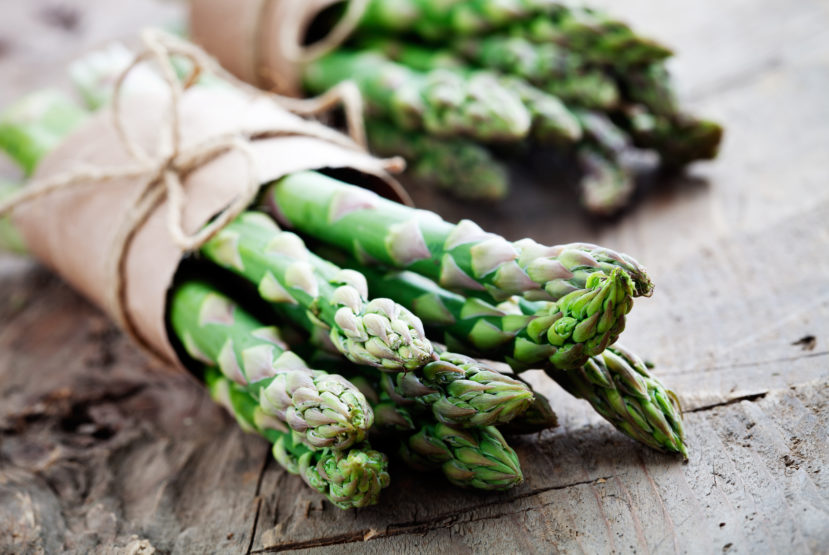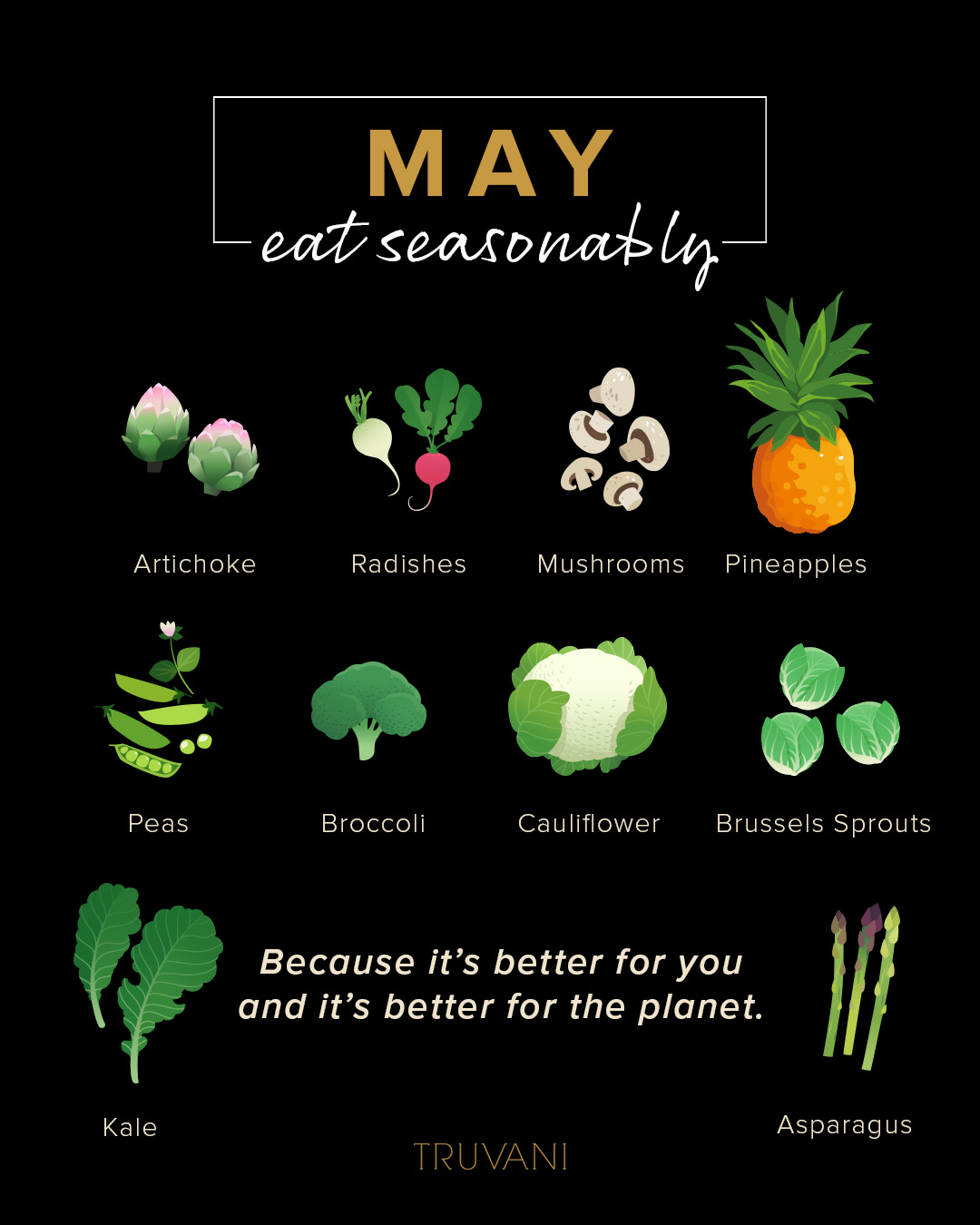From Our Table to Yours: May Seasonally Eating Edition

Ever think about how you can eat fresh berries in the winter or avocado year-round? Food transportation allows our favorite produce to land in stores no matter the season.
But we shouldn’t take this for granted. Seasonal eating is a great way to support your local economy, the planet, and your wallet.
We put together a series of seasonal eats and are kicking it off with our May edition. But first, let’s break down why seasonal eating is so important.
Why is seasonal eating important?
It’s healthier for you 🥬
Foods grown and harvested during the right season are packed with more nutrients. This is because foods have a natural growth cycle and ripening cadence that is perfected during certain times of the year.
When you find out of season produce in the store, it’s likely treated with ripening agents. These are chemicals, gases, and heat processes that speed up the ripening process so the food can go to market. Plus, some fruits and veggies are coated with an edible (we use that term loosely) film to protect it — which is why some apples feel waxy.
It’s better for your tastebuds 🥦
Nothing beats fresh food picked from the garden. Farmers grow mass quantities of produce to meet global demands, but this is at the expense of taste.
When volume is the name of the game, farmers focus more on selective breeding to meet appearance standards and care less about overall flavor quality. Those strawberries may look pretty in the plastic carton, but they won’t taste as sweet as the ones from your local farmer’s crop.
It’s better for the planet 🌎
Transportation is one of the largest producers of greenhouse emissions. When you pick up an apple from New Zealand in your California market, do you ever think about how it got there?
Long-distance travel doesn’t just affect the flavor and nutrient profile of your food. It also leaves a lasting market on the environment. Buying locally and in season reduces the amount of carbon used to transport the food from a farm to your table.
It’s easier on your wallet 🍍
When local farmers can harvest seasonal produce, they have a surplus that sells at a more reasonable price. Think about those berries you buy out of season that are likely double the price. That grower has to pass along the cost of transportation and artificial ripening onto the consumer.
Now that you understand why seasonal eating is better, let’s dig into what you can find locally this spring.
What seasonal produce should I look for in May?
Spring is all about greens. You’ll likely find a good amount of the following at your local markets:
Artichoke
Asparagus
Broccoli
Brussels sprouts
Cauliflower
Kale
Mushroom
Peas
Pineapple
Radish

Artichoke
Artichokes are abundant. In fact of the 140 varieties, 40 of them are grown commercially as food products. You likely find the French artichoke on most tables, with the ‘heart’ being the edible portion of the plant.
Artichokes are rich in folate, Vitamin C, and Vitamin K. Plus, these green globes contain a good amount of fiber and other beneficial nutrients.
Asparagus
There are over 300 species of asparagus around the world, and this classic veggie is found mostly native to Europe, western Asia, and northern Africa.
This nutrient-dense plant is high in folic acid and is a good source of potassium, fiber, vitamin B6, vitamin A and vitamin C, and thiamine.
Broccoli
Broccoli is part of the cabbage family, which is part of the larger plant family called Brassica oleracea. It’s an excellent source of phytochemicals called isothiocyanates that support your body’s fight against free radicals.
It also packs glucosinolates, carotenoids, chlorophyll, vitamins E and K, essential minerals, phenolic compounds, and a host of other powerful nutrients.
Broccoli comes in a variety of different options, so shop around and try something new this season.
Brussels sprouts
Brussels sprouts (Brassica oleracea) are grouped in the cruciferous family along with broccoli. Brussels sprouts are rich in antioxidants that support digestive health, heart health, and more. These little green machines also have a high amount of protein for a vegetable.
Cauliflower
Cauliflower is also a member of the Brassica oleracea family. Along with other veggies in this family, cauliflower is an excellent source of natural antioxidants, essential vitamins, carotenoids, fiber, soluble sugars, minerals, and phenolic compounds.
Kale
All hale to kale! Kale is one of the most common veggies found in these superfood bunch. This leafy friend comes from the Acephala group of the Brassica oleracea (oleracea var) species, which also includes collard greens.
Green and purple are the two main varieties, and it’s nutrition profile provides a wide array of essential vitamins, minerals, and antioxidants.
Mushroom
Mushrooms are often grouped in with veggies, but they are a type of beneficial fungi. The term “mushroom” refers to any macro fungus with a body large enough to be picked by hand.
We currently know of at least 14,000 different plant species — but scientists believe this is only 10% of what’s out there. Mushrooms are low in carbohydrates and calories, and a great source of B vitamins, trace minerals, fiber, and even protein.
Peas
These small but mighty veggies pack in tons of nutrients and health benefits. Peas are rich in pea protein and fiber to support healthy weight and digestion, plus they boast a high amount of antioxidants as well as micronutrients, such as vitamin K, vitamin C, and manganese.
Pineapple
Pineapple (species name Ananas comosus) is a tropical plant that sprouts a delicious fruit. This fruit is packed with vitamin C and other phytonutrients that support overall wellness. Plus, pineapple has the protein-digesting enzyme called bromelain.
Radish
Radishes are members of the Brassicaceae family, which also includes mustard greens and cabbage. The radish is an alkaline-forming food, which helps maintain pH balance in the body. Plus, they are an excellent source of vitamin C.
Radish is often used in salads but is also fermented and pickled for great toppers and condiments. Other popular radish varieties include Daikon and horseradish.
Wrapping It Up
Some of your local grocers may source produce locally and seasonally. You can also head to your weekly farmers market, join a CSA, or hit the roadside stands when available.
Be the first to know about our seasonal eating posts by following us on Instagram @Truvani!


Comments